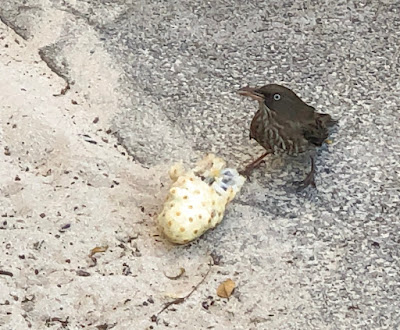Over the years people living in the Virgin Islands have brought in donkeys, mongooses, deer, cats and chickens, many of which can now be seen scavenging on the local beaches. The Pearly-eyed Thrashers, locally called ‘thrushies’, consider themselves to have first dibs on food at the beach, and do not appreciate the interlopers.While it is certainly interesting to see an exotic mongoose at the beach, you might be less amused if one drops in on your picnic and makes off with unattended snacks.I once noticed a paper bag lying on the beach that was shaking strangely. As I went to investigate, a mongoose slid out with a sandwich and snuck off before the owner returned.Mongooses were introduced on plantations in the late 1800s, to help catch the rats that had tagged along on boats from Europe and eagerly took to eating sugar cane. The mongooses did deal with some of the rats, but also found other native food sources. Their descendants now not only steal sandwiches, but also raid the nests of sea turtles, ducks, shorebirds and iguanas, and have eaten many of the indigenous lizards and snakes. They also impact trees and plants, consuming seeds, birds that are seed dispersers, and insects that serve as native plant pollinators.Meanwhile, rats are still around too, similarly eating eggs, lizards and insects, plus seeds and plants.In addition, cats were brought to the islands, some as pets, and others maybe to help catch the rats. Over the years, many cats were abandoned, or otherwise ended up fending for themselves in the wild. Though there are programs now to feed them and keep them from reproducing, some cats still haunt the beaches and bushes, hunting native lizards, birds and rodents.
 |
| Feral and outdoor cats are avid hunters of island wildlife. |
You can also see packs of donkeys tromping around, including along the beaches. The donkeys were originally brought to the islands to help with the work on plantations. Later they were used for transportation. Then when cars became available, some of the donkeys were let loose to mostly fend for themselves.The donkeys normally eat grasses, but will sometimes also chomp or trample on native plants that might be important for island ecosystems. They are also experts at taking food from people’s bags left on the beach, and can become aggressive if you try to shoo them off. They can easily get into backpacks and will cheerfully tear into bags of chips, even though inappropriate food is harmful to them, causing diseases and weird fatty deposits.White-tailed Deer are the worst about destroying valuable native plants. They especially enjoy mangrove seedlings, which can damage the capacity of mangrove wetlands to rebound after hurricanes. The deer were transported to the islands many years ago to be hunted for sport, and meat. But hunting them is now illegal, despite their rapid rate of reproduction. They too run freely along the beaches, and you can often see a line in the vegetation indicating how high they can reach when they are browsing.In some areas, introduced birds like peacocks can be seen foraging along the water’s edge, competing with local birds for seeds and berries, as well as insects and lizards.Formerly domesticated chickens, too, compete with wild birds for fruits and other food on the beaches.
 |
| A rooster considers whether or not to eat an overripe starvation fruit (Noni). |
The much smaller Pearly-eyed Thrashers are not happy to have their territory invaded.Although the ‘thrushies’ are resourceful and resilient, they can’t keep all the intruders off the beaches by themselves. And the cumulative impact of so many hungry scavengers has decimated some of the native plants, birds and animals. Others survive only on the smaller cays, where they can sometimes find better protection and seclusion, especially if there are effective rat and mongoose eradication programs in effect.





